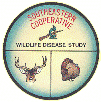Southeastern Cooperative Wildlife Disease Study

Southeastern Cooperative Wildlife Disease Study: Publications
Document Type
Article
Date of this Version
January 2003
Abstract
• The Latest on chronic wasting disease (CWD): Wisconsin, Illinois, Colorado, South Dakota, Wyoming, Nebraska, Saskatchewan
• The Wildlife Society (TWS) recently published a technical review and draft position statement on the confinement of wild ungulates within fenced enclosures--"Biological and Social Issues Related to Confinement of Wild Ungulates."
• Exotic Newcastle disease (END) was confirmed in backyard poultry flocks in southern California on October 1, 2002.
• Southern Tick-Associated Rash Illness (STARI): In the northeastern United States, Borrelia burgdorferi, the causative agent of Lyme disease, is maintained in nature through a cycle involving the white-footed mouse and other rodents as primary reservoir hosts and the blacklegged tick, Ixodes scapularis, as vector.
• White-tailed deer tissue samples submitted to SCWDS for bluetongue (BT) and epizootic hemorrhagic disease (EHD) virus isolation reached record proportions this year due to a major outbreak of hemorrhagic disease (HD) that extended from Georgia to Pennsylvania.
• Renal Coccidiosis Agent Investigated: From 1984 to 2001, more than 1,200 doublecrested cormorants (Phalacrocorax auritus) are known to have died of renal coccidiosis during 10 mortality events in Georgia, Iowa, Kansas, Minnesota, Nebraska, and South Carolina. The parasite was described and named Eimeria auritusi in an article authored by SCWDS researchers and published in the December 2002 issue of The Journal of Parasitology 86(6): 1230-1233.
• The results of the 2001 National Survey of Fishing, Hunting, and Wildlife Associated Recreation recently were released by the U.S. Fish and Wildlife Service.

